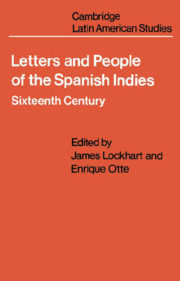Book contents
- Frontmatter
- Contents
- Preface
- Part I Conquest
- Part II The Variety of Life in the Indies
- 11 An encomendero's establishment
- 12 An encomendero's opinions
- 13 The miner
- 14 Commerce across the Atlantic
- 15 The professor of theology
- 16 The new arrival
- 17 The tanner and his wife
- 18 The troubadour
- 19 The nephew
- 20 The garden and the gate
- 21 The woman as settler
- 22 The farmer
- 23 The petty dealer
- 24 The Flemish tailors
- 25 The nobleman
- 26 The Hispanized Indian
- 27 Indian high society
- 28 An Indian town addresses the king
- Part III officials and Clerics
- Bibliography
- Index
26 - The Hispanized Indian
from Part II - The Variety of Life in the Indies
Published online by Cambridge University Press: 06 August 2018
- Frontmatter
- Contents
- Preface
- Part I Conquest
- Part II The Variety of Life in the Indies
- 11 An encomendero's establishment
- 12 An encomendero's opinions
- 13 The miner
- 14 Commerce across the Atlantic
- 15 The professor of theology
- 16 The new arrival
- 17 The tanner and his wife
- 18 The troubadour
- 19 The nephew
- 20 The garden and the gate
- 21 The woman as settler
- 22 The farmer
- 23 The petty dealer
- 24 The Flemish tailors
- 25 The nobleman
- 26 The Hispanized Indian
- 27 Indian high society
- 28 An Indian town addresses the king
- Part III officials and Clerics
- Bibliography
- Index
Summary
Don Martin, Indian nobleman, interpreter and encomendero, to rebel governor Gonzalo Pizarro in Lima, 1547
… I have my hair cut, by which I would be very easily recognized …
The Indians of the whole vast reach of South and Central America were affected by the sixteenth-century European presence: by epidemic disease, demands for new kinds of tribute and labor, reduction of their own interregional trade, addition of new techniques, plants and animals, reorganization of local political and religious life, and much more. The majority of the population, however, long continued to live in the same provincial and local units as before, within a functioning Indian society which retained its vitality and viability. These people had little direct contact with the Spanish life of the cities, to which they were tied only through encomienda obligations and the relatively few secular and ecclesiastic encomienda representatives who came out into the countryside.
Two types of Indians did come into direct and frequent contact with Spaniards. The first, and the more important for the growth and transformation of Spanish American society, were the Spaniards’ permanent servants, employees and dependents. The tribute and temporary labor provided by the encomienda were not enough. The Spaniards needed auxiliaries, people on a permanent basis who would learn something of their skills and their language, and who could then be their trusted retainers, or work at skilled crafts, or help with maintenance and supervision in their enterprises. The most prominent such auxiliaries were the ubiquitous blacks, whether as slaves or freedmen. From the beginning there were Indians in this role as well, who came to outnumber the blacks by far, and before the end of the colonial period had supplanted them in many areas.
Indian societies of many parts of America already knew not only nobles and commoners, but a third type: the person, often an outsider, who was the direct dependent of a nobleman, rather than sharing in general community obligations and rights. It was easy for the Spaniards to utilize such people, simply transferring the allegiance from an Indian nobleman to a Spaniard; even when the persons employed or commandeered were not of the dependent class, the existence of the type and function in preconquest society gave a framework of expectations.
- Type
- Chapter
- Information
- Letters and People of the Spanish IndiesSixteenth Century, pp. 155 - 159Publisher: Cambridge University PressPrint publication year: 1976



